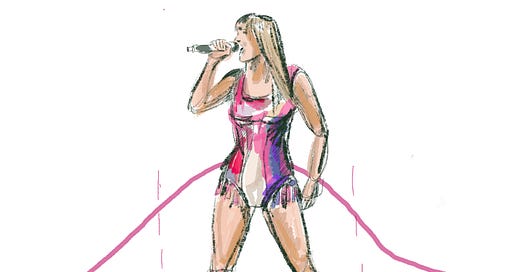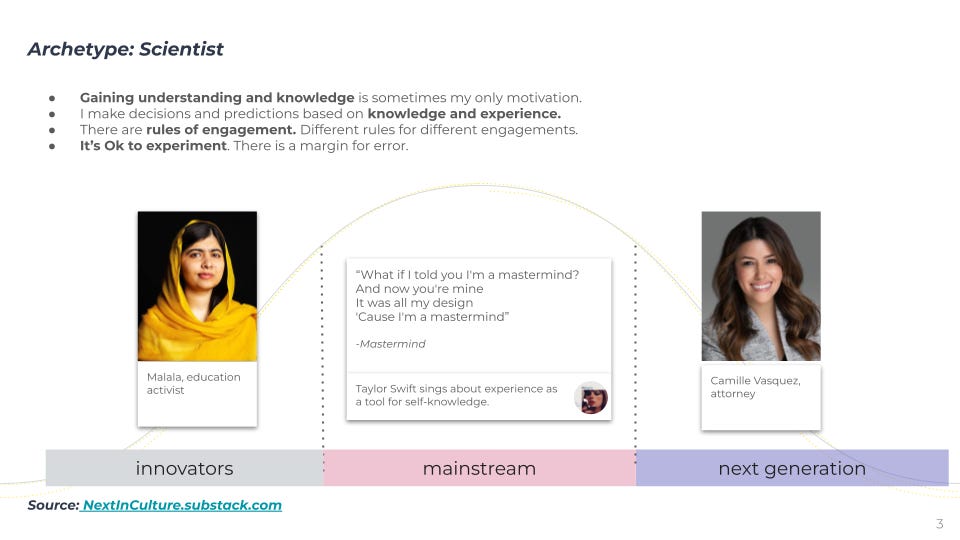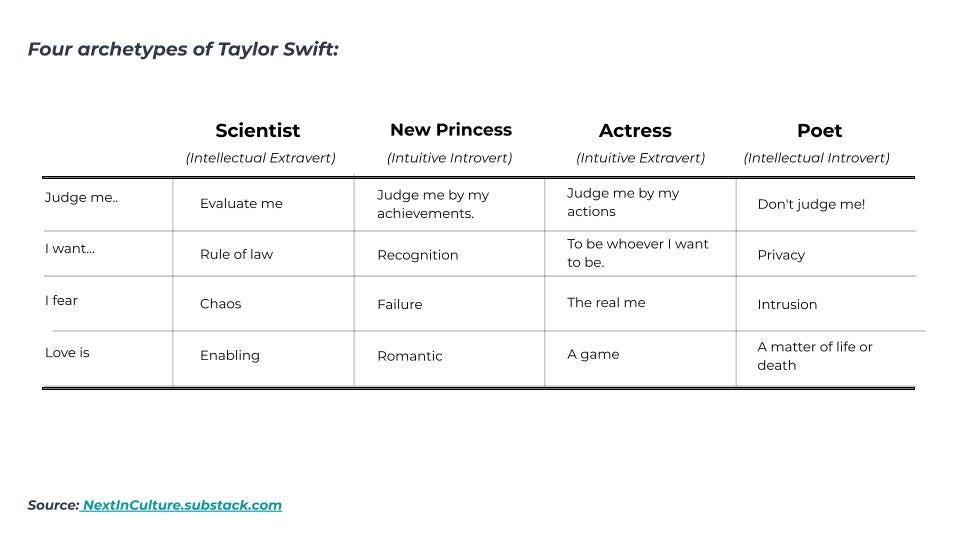Four archetypes of Taylor Swift: stories waiting to be told
Episode 2: What Every Storyteller Should Learn From Taylor Swift
Art History taught me that, historically, women didn’t have time to think thoughts - they were too busy napping naked alone in a forest. (Hannah Gadsby, comedian and writer)
For a very long time, the theme of the media was that Swift was overrated: she needed collaboration and better advice. And all her songs sounded the same. But who cares what critics say when your product is validated on a mass-cultural scale?
Through her popularity - 53% of Americans identify as Swifties - and by building on existing models, Taylor has brought her idea of what it means to be a woman into the mainstream. By doing this, she created new archetypes for today’s US culture.
Taylor’s representation of women in American pop culture is complex. She represents a certain type of woman. They are typically middle class, and mostly white. Taylor’s version of representation in the context of intersectionality deserves its own space, so stay tuned for Part 3. Meanwhile, here we deep dive into the emerged archetypes that Swift propelled into the mainstream.
Archetypes are the building blocks we use to construct our societal narrative. They are the foundations of our culture. Role models are archetypes made personal, real, and relatable. Archetypes offer simple solutions to difficult questions. They give us "timeless" answers to current problems: Should I obey my father? How do I know who my friends are?
From Pandora with her box to Beauty and her Beast, traditional female role models have featured in sinister stories featuring witches, rabbit holes and monsters. The girls are often as naked as Botticelli’s Venus. Dehumanized bodies had no identity without the man who painted them: Female Nude by Picasso. We don't even know for sure who the Mona Lisa was.
By the millennium, not much had changed. The Sex and the City movie showcased the “only two choices for women” for a new century: the sexy kitten and the witch - the virgin and the crone, the desired and the discarded.
If we are to tell a new story, we need new narrative paradigms for storytellers. Swift’s songbook contains a wealth of possibilities.
By plotting Taylor Swift’s lyrics/eras into themes, and then contextualizing them against the pre-existing cultural movements, we defined 4 basic archetypes to inspire the next generation of storytellers.
The examples we give - role models past, present and perhaps future - are not exhaustive, and reflect a position in popular culture. They are more about cultural iconography than the personalities behind the faces. If you can come up with further examples, send them our way.
Archetype 1: Scientist
What happens if I act like a man?
The scientist uses relevant information to make calculated decisions. She assesses people and situations, she evaluates probabilities. She learns through experience. Learning is good. Experimentation is good. Learning is an active, lifelong process, not just a series of mistakes.
Malala on Breaking Into Hollywood and Why She Loves 'Stranger Things'
For my brothers it was easy to think about the future. They can be anything they want. But for me it was hard and for that reason I wanted to become educated and empower myself with knowledge.
How Johnny Depp’s fandom turned its focus to his lawyer Camille Vasquez
I was the best person for the job. I was the hardest working, and I was the most prepared.
Taylor's Songs: Getaway Car, The Man, Picture to Burn, Never ever ever getting back together
Archetype 2: The Actress
What happens when I choose who I want to be?
Pleasing the audience is not so important, but pleasing herself is. She’s the main character in her own story. She has the power to decide when to be on stage and when to be herself. She does not confuse the two. She likes trying on different looks.
Why Marilyn Monroe is the world's most misunderstood icon
She stands for different narratives: the victim narrative, and the absolute essence of feminine, sexual glamor and irresistibility, in her own lifetime and in retrospect [...] People relate to her as someone struggling and trying very hard to be taken seriously as a dramatic actress. -Dr Lucy Bolton
Where Is Anna Delvey Now? All About the Fake Heiress' Life After Prison
When you’re angry, you’re just a character in someone else’s story. But when you let your anger go, you reclaim your own story. Become your own protagonist again. -Inventing Anna
Taylor Songs: Better than Revenge, All Too Well
Archetype 3: New Princess
What if I just be myself?
Historically, there were only two ways to be a princess: to be born that way or to marry a prince. Taylor’s princess wants to be recognized for who she really is, not what she is.
She wants to make her own choices. While the Actress reserves the right to be whoever she wants to be, the Princess demands to be allowed to be herself and to be recognized for it.
Why do we remain captivated by Princess Diana?
People think that at the end of the day a man is the only answer. Actually, a fulfilling job is better for me.
In 'She-Ra And The Princesses Of Power,' True Strength Is In Being Yourself
I didn't break the world, but I am going to fix it.
Taylor Songs: The Best Day, White Horse, Speak Now
Archetype 4: Poet
Everything is not about me, but what if it is?
The poet lives to express the truth about her world, internal and external. She is driven by aesthetics, not logic. She does not need to be authorized or validated.
Sylvia Plath: Will the poet always be defined by her death?
After all, we are nothing more or less than we choose to reveal.
Why Olivia Rodrigo might be our last pop superstar
If someone tells me one more time 'Enjoy your youth,' I'm gonna cry.
Taylor Songs: The 1, Fifteen, Soon you’ll get better
Ok. So what?
We live in Taylor’s version of our culture. Her fandom is a powerful cultural force. Her economic power moves markets. And her storytelling is a Holywood-ready lesson on how to stay relevant in the modern, highly competitive world.
Hollywood needs help. It is slow to innovate, and keep recyclinging the same old stories about the same type of people in the same type of situation. (According to the Hollywood Diversity Report women still take up only a third of the leading roles in movies, and the share is actually decreasing.)
Arguably, Barbie - the story of a new princess - was one of the first movies to tap into the four new Swift-driven archetypes.
Culture, of course, does go beyond Taylor Swift and her fans, but these four archetypes give creators a start in catering to a vastly underserved market.











